In my current project investigating the categorical semantics of attack trees we are using distributive laws to compose comonads that model various structural rules – weakening, contraction, exchange, etc – in linear logic. During the QA section of my talk at Linear logic, mathematics and computer science – see my post on my talk and the workshop for more details – Paul-André Melliès suggested using adjunctions to compose the structural rules instead of distributive laws for the obvious reason that they really compose as opposed to monads/comonads. I told him that I did try to this initially, but was not able to get it working. He was nice enough to talk with me a bit and gave me some hints to how it works which are based on a paper of his.
Instead of just looking up the details in his paper I wanted to see if I could recreate his result with his hints. I often do this for learning purposes. So that’s what I did during my flight back from France. I figured why not make it a blog post. Keep in mind that this result is due to Paul-André, but I had a lot of fun recreating his steps.
I plan to write a follow up post describing how this result can be used to to create various adjoint models of linear logic, but here we show that when we have two comonads on a category with a distributive law, then those comonads in addition to their composition can be decomposed into a composition of adjunctions between their coalgebras.
Suppose \[(k,\varepsilon,\delta)\] is a comonad on a category \[\cat{L}\]. Then it is well known that it can be decomposed into the following adjunction: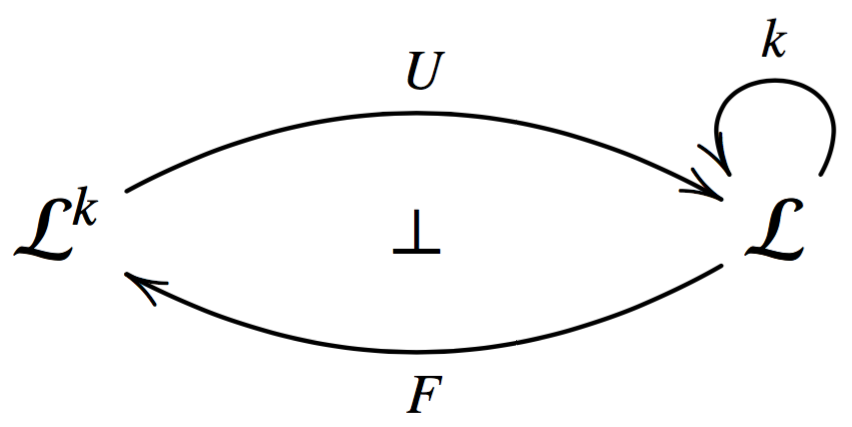
where \[U : \cat{L}^k \mto \cat{L}\] is the forgetful functor, \[F : \cat{L} \mto \cat{L}^k\] is the free functor, and \[k = UF : \cat{L} \mto \cat{L}\].
Now suppose we have the following adjunctions:

Keep in mind that this gives rise to a comonad \[HFGJ : \cat{L}_1 \mto \cat{L}_1\].
We are going to use these two facts to compose comonads using adjunctions. Suppose we have the comonads \[(k_1,\varepsilon^1,\delta^1)\] and \[(k_2,\varepsilon^2,\delta^2)\] both on a category \[\cat{L}\] with a distributive law – distributive laws for comonads are defined to be the opposite of the distributive laws for monads – \[\mathsf{dist} : k_2k_1 \mto k_1k_2\]. Thus, making \[k_2k_1 : \cat{L} \mto \cat{L}\] a comonad.
Then we can decompose \[k_1\] into a an adjunction: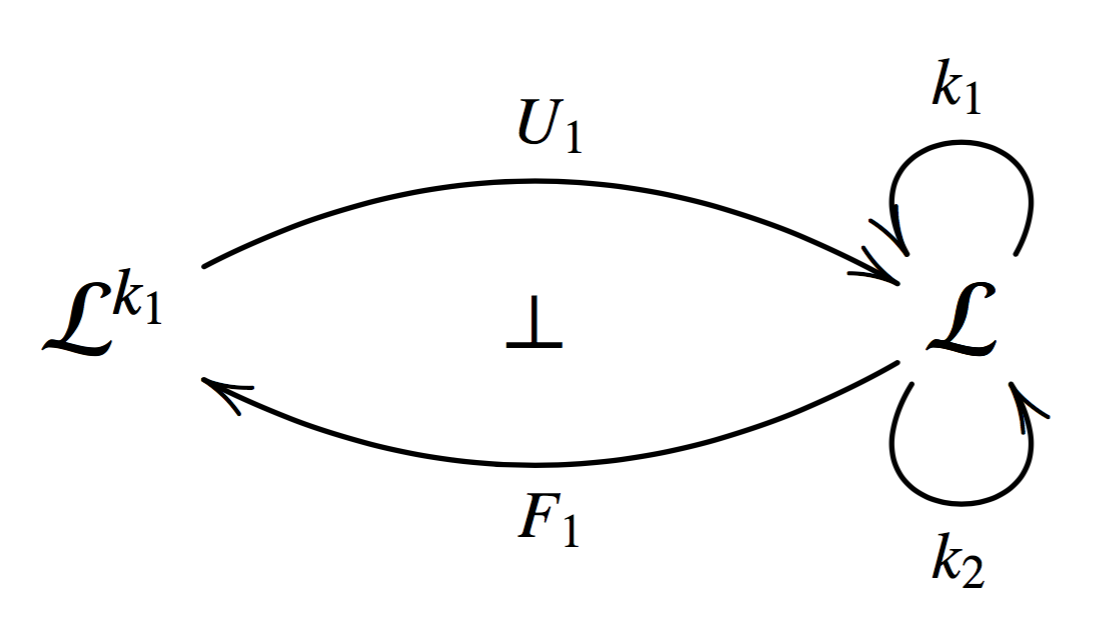
Here we know that \[k_1 = U_1F_1 : \cat{L} \mto \cat{L}\], but we also know something about \[k_2\]. We can extend it to a comonad on \[\cat{L}^{k_1}\].
First, we define the functor \[\widetilde{k}_2 : \cat{L}^{k_1} \mto \cat{L}^{k_1}\] to send objects \[(A,h_A)\] to \[(k_2A,h'_A)\], where \[h'_A := k_2A \mto^{k_2h_A} k_2k_1 A \mto^{\mathsf{dist}_A} k_1k_2 A\], and to send morphisms \[f : (A,h_A) \mto (B,h_B)\] to the morphism \[k_2f : (k_2A,h'_A) \mto (k_2B,h'_B)\]. We must show that \[k_2f : k_2A \mto k_2B\] is a coalgebra morphism, but the following diagram commutes: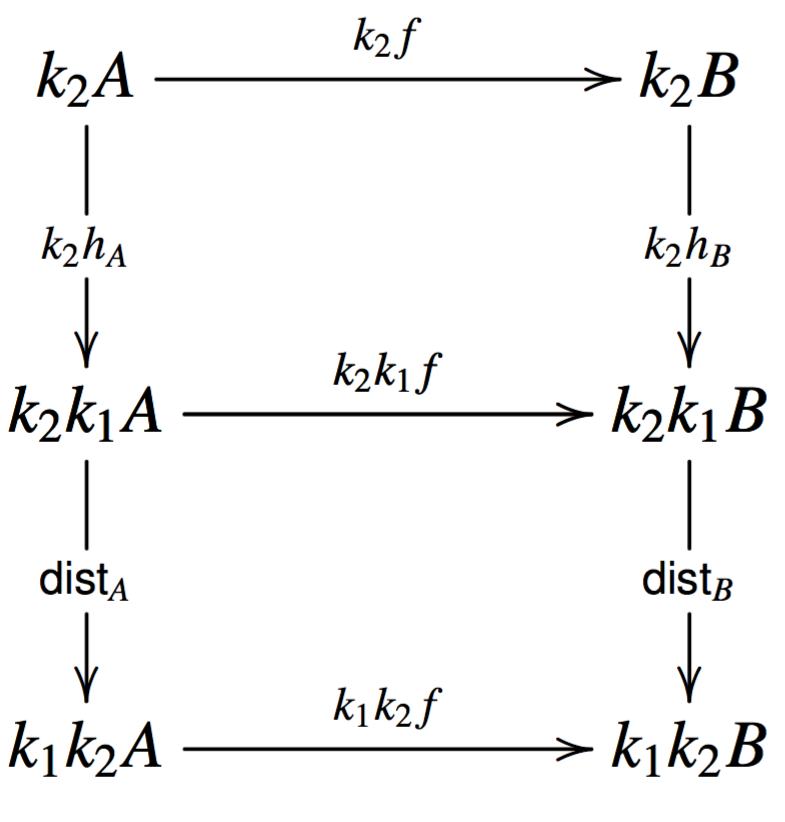
The top diagram commutes because \[f\] is a coalgebra morphism and the bottom diagram commutes by naturality of \[\mathsf{dist}\]. Since the morphism part of \[\widetilde{k}_2\] is defined using the functor \[k_2\] we know \[\widetilde{k}_2\] will respect composition and identities.
We now must show that \[\widetilde{k}_2\] is a comonad. The natural transformation \[\widetilde{\varepsilon^2} : \widetilde{k}_2 \mto \mathsf{Id}\] has components \[\widetilde{\varepsilon^2}_{(A,h_A)} = \varepsilon^2_A : \widetilde{k}_2 (A,h_A) \mto (A,h_A)\]. We must show that \[\varepsilon^2_A\] is a coalgebra morphism between \[\widetilde{k}_2 (A,h_A) = (k_2A,k_2h_A;\mathsf{dist}_A)\] and \[(A,h_A)\], but this follows from the following diagram: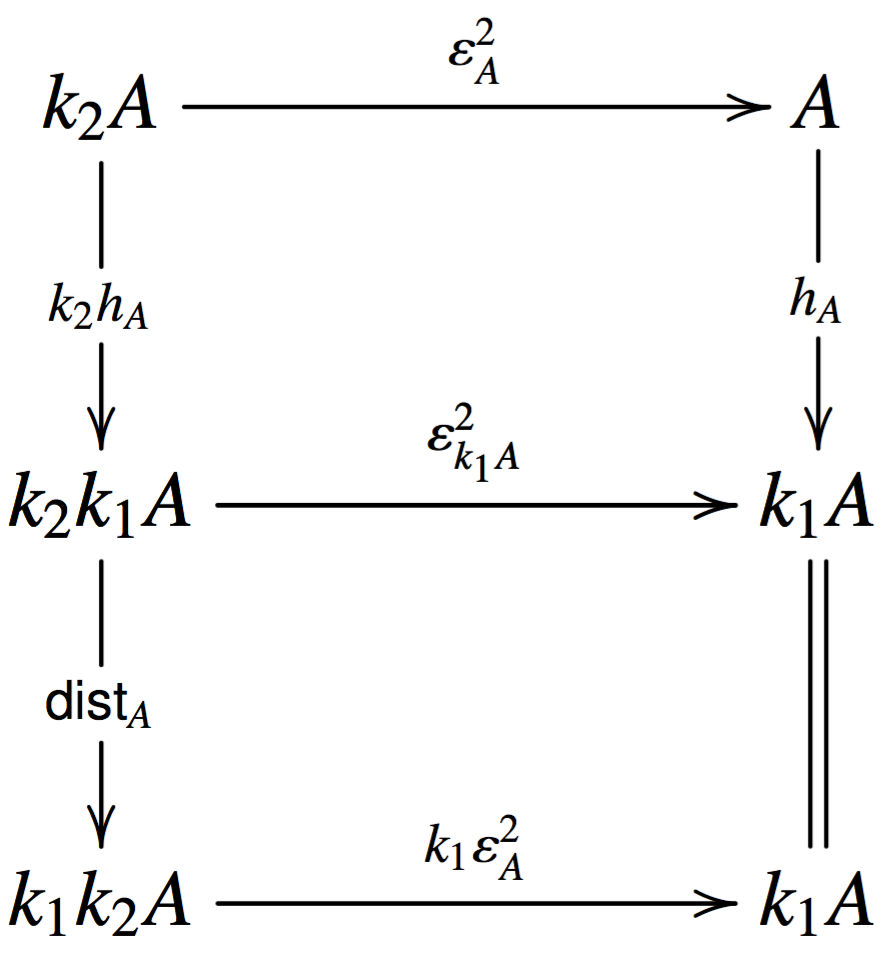
The top diagram commutes by naturality of \[\varepsilon^2\] and the bottom diagram commutes by the conditions of the distributive law. Naturality for \[\widetilde{\varepsilon^2}\] easily follows from the fact that it is defined to be \[\varepsilon_2\].
The natural transformation \[\widetilde{\delta^2} : \widetilde{k_2} \mto \widetilde{k_2}\widetilde{k_2}\] has components \[\widetilde{\delta^2}_{(A,h_A)} = \delta^2_A : \widetilde{k_2}(A,h_A) \mto \widetilde{k_2}\widetilde{k_2}(A,h_A)\]. Just as above we must show that \[\delta^2_A : k_2A \mto k^2_2 A\] is a coalgebra morphism between \[\widetilde{k_2}(A,h_A) = (k_2A,k_2h_A;\mathsf{dist}_A)\] and \[\widetilde{k_2}\widetilde{k_2}(A,h_A) = (k^2_2A,k^2h_A;k_2\mathsf{dist}_A;\mathsf{dist}_{k_2A})\], but this follows from the following diagram: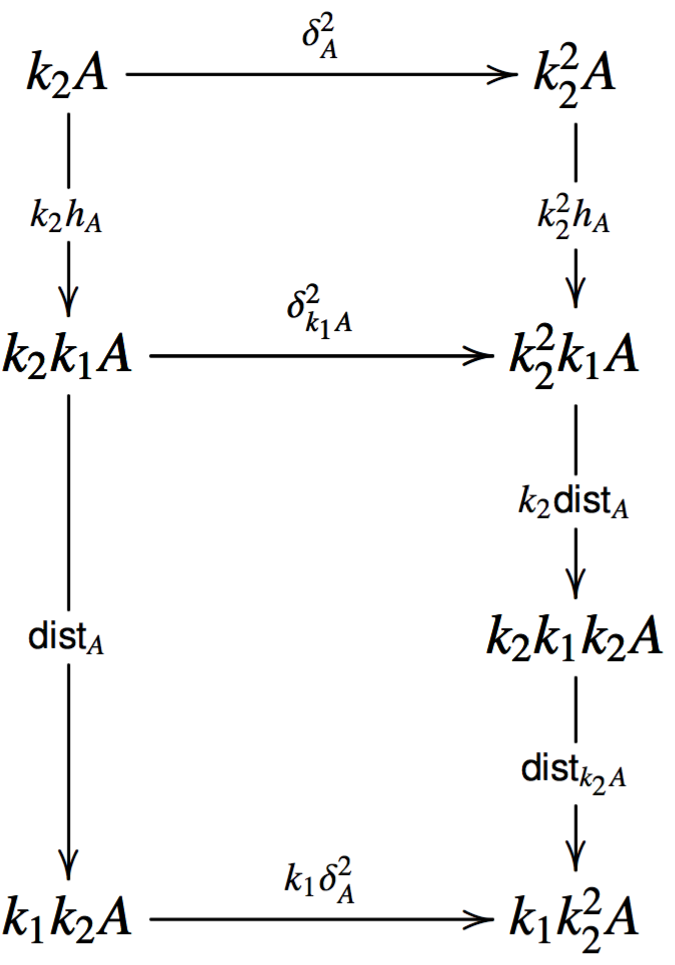
The top diagram commutes by naturality of \[\delta^2\] and the bottom diagram commutes by the conditions of the distributive law.
It is now easy to see that \[\widetilde{\varepsilon^2}\] and \[\widetilde{\delta^2}\] make \[\widetilde{k_2}\] a comonad on \[\cat{L}^{k_1}\], because the conditions of a comonad will be inherited from the fact that \[\varepsilon^2\] and \[\delta^2\] define a comonad on \[\cat{L}\].
At this point we have arrived at the following situation: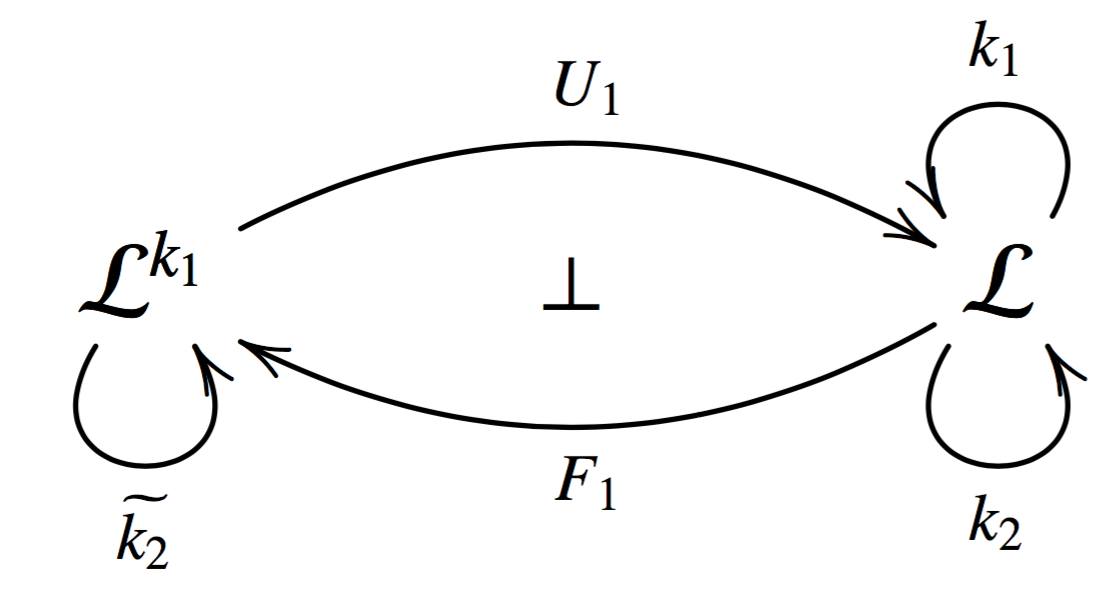
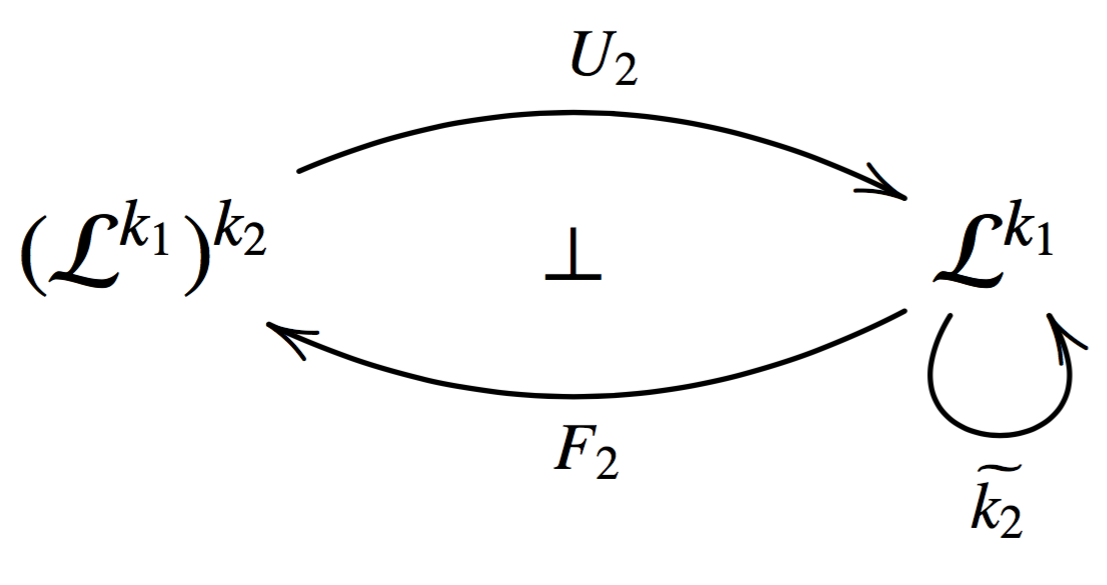
The functor \[F_2(A,h_A) = (\widetilde{k_2}(A,h_A), \widetilde{\delta^2}_{(A,h_A)})\] is the free functor, and \[U_2(A,h_A) = A\] is the forgetful functor. Thus, we can think of \[(\cat{L}^{k_1})^{k_2}\] as the world with all the structure of \[\cat{L}\] extended with all of the structure \[k_1\] brings and all the structure \[k_2\] brings. That is, \[(\cat{L}^{k_1})^{k_2}\] is the algebras of \[k_2k_1 : \cat{L} \mto \cat{L}\].
We can see that the previous two adjunctions compose:
Therefore, the above adjunction gives back the composition \[k_2k_1 : \cat{L} \mto \cat{L}\].
This result only works because we have a distributive law, but the distributive law is only used in the the definition of the structural map of the coalgebras. This result reveals a means that will allow us to abandon distributive laws in favor of adjunctions in the spirit of Benton’s LNL models, however, doing so comes with some different difficulties. Stay tuned!